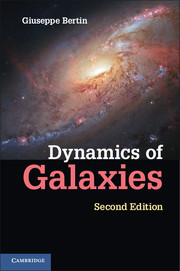Book contents
- Frontmatter
- Contents
- Preface to the Second Edition
- Preface to the First Edition, 2000
- Acknowledgments
- PART I Basic Phenomenology
- PART II Physical Models
- 6 Self-Gravity and Relation to Plasma Physics
- 7 Relaxation Times, Absence of Thermodynamical Equilibrium
- 8 Models
- 9 Equilibrium and Stability: Symmetry and Symmetry Breaking
- 10 Classical Ellipsoids
- 11 Introduction to Dispersive Waves
- 12 Jeans Instability
- PART III Spiral Galaxies
- PART IV Elliptical Galaxies
- PART V In Perspective
- Bibliography
- Index of objects
- Index
9 - Equilibrium and Stability: Symmetry and Symmetry Breaking
from PART II - Physical Models
Published online by Cambridge University Press: 05 June 2014
- Frontmatter
- Contents
- Preface to the Second Edition
- Preface to the First Edition, 2000
- Acknowledgments
- PART I Basic Phenomenology
- PART II Physical Models
- 6 Self-Gravity and Relation to Plasma Physics
- 7 Relaxation Times, Absence of Thermodynamical Equilibrium
- 8 Models
- 9 Equilibrium and Stability: Symmetry and Symmetry Breaking
- 10 Classical Ellipsoids
- 11 Introduction to Dispersive Waves
- 12 Jeans Instability
- PART III Spiral Galaxies
- PART IV Elliptical Galaxies
- PART V In Perspective
- Bibliography
- Index of objects
- Index
Summary
Much of the study of the dynamics of collective systems proceeds through investigation of the properties of equilibrium configurations (often referred to as basic states) and analysis of their stability with respect to a variety of perturbations. The choice of the equilibriumstate is primarily a choice of symmetry. The study of how perturbations evolve on such a basic state is thus a study of the mechanisms that lead to a breaking of the assumed symmetry (although we may consider perturbations that preserve the original symmetry). Obviously, the simplest case that can be considered is that of the linear limit, in which perturbations have vanishingly small amplitudes, much as in the case of small oscillations for a system of point masses in classical mechanics.
In this chapter, general remarks are made about this common framework, and some interesting consequences for the internal structure of collisionless stellar systems are noted. By means of a nontrivial example from plasma physics and an elementary example from classical mechanics, some key concepts are demonstrated and a few important issues are raised that will be found later to be a common thread in the study of the dynamics of normal galaxies. In Chapter 10, the main results and some technical aspects of the process of studying equilibrium and stability for one relatively simple class of self-gravitating fluids, that is, the classical ellipsoids, are summarized.
Within the above-mentioned framework it is implicitly assumed that in many observed systems, some simple symmetries are approximately realized, which is intuitively true.
- Type
- Chapter
- Information
- Dynamics of Galaxies , pp. 95 - 104Publisher: Cambridge University PressPrint publication year: 2014



